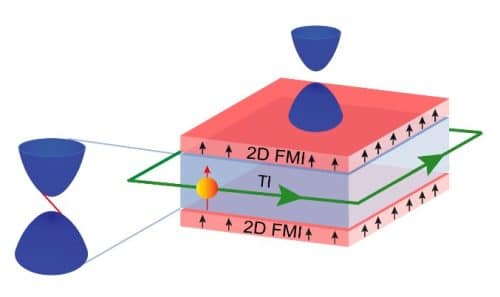A transistor made using this technology would utilise lossless paths flowing along a topological insulator’s edges.
A Monash University-led research team has revealed that a large-bandgap quantum anomalous hall insulator can be created by sandwiching an ultra-thin topological insulator between two 2D ferromagnetic insulators. This type of heterostructure opens the door to ultra-low-energy future electronics and even topological photovoltaics.
A ferromagnetic material serves as the “bread” of the sandwich while a topological insulator (a material with nontrivial topology) serves as the “filling”. Quantum Anomalous Hall (QAH) insulators, as well as exotic quantum phases like the QAH effect are created by combining magnetism with nontrivial band topology. To achieve the QAH effect at higher temperatures, a viable technique is inducing magnetic order in topological insulators by proximity to a magnetic material.

This study used molecular beam epitaxy to construct a MnBi2Te4 / Bi2Te3 /MnBi2Te4 heterostructure and angle resolved photoelectron spectroscopy to examine the its electrical structure. Magnetic order (an exchange interaction with the 2D Dirac electrons) is induced in the ultra-thin topological insulator Bi2Te3 by the 2D MnBi2Te4 ferromagnets via magnetic proximity.
However, due to the unwanted influence of the abrupt interface potential that emerges due to lattice mismatch between the magnetic materials and the topological insulator, creating sufficient magnetic order is difficult. “To minimize the interface potential when inducing magnetic order via proximity, we needed to find a 2D ferromagnet that possessed similar chemical and structural properties to the 3D topological insulator” says Qile Li, who is also a PhD student with the Australian Research Council Center for Excellence in Future Low-Energy Electronic Technologies (FLEET).
The researchers were also able to confirm the electrical structure, gap size, and temperature at which the QHE phenomenon is likely to occur in this MnBi2Te4 / Bi2Te3 / MnBi2Te4 heterostructure. “These findings provide insights into magnetic proximity effects in topological insulators, which will move lossless transport in topological insulators towards higher temperature,” says Monash group leader and lead author Dr Mark Edmonds.
This study was published in Advanced Materials in March 2022.








